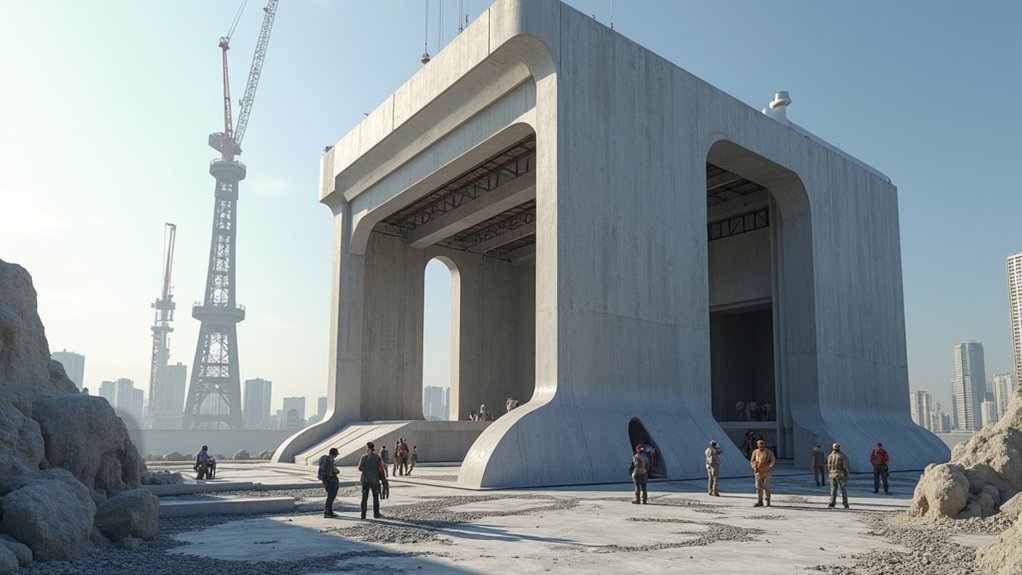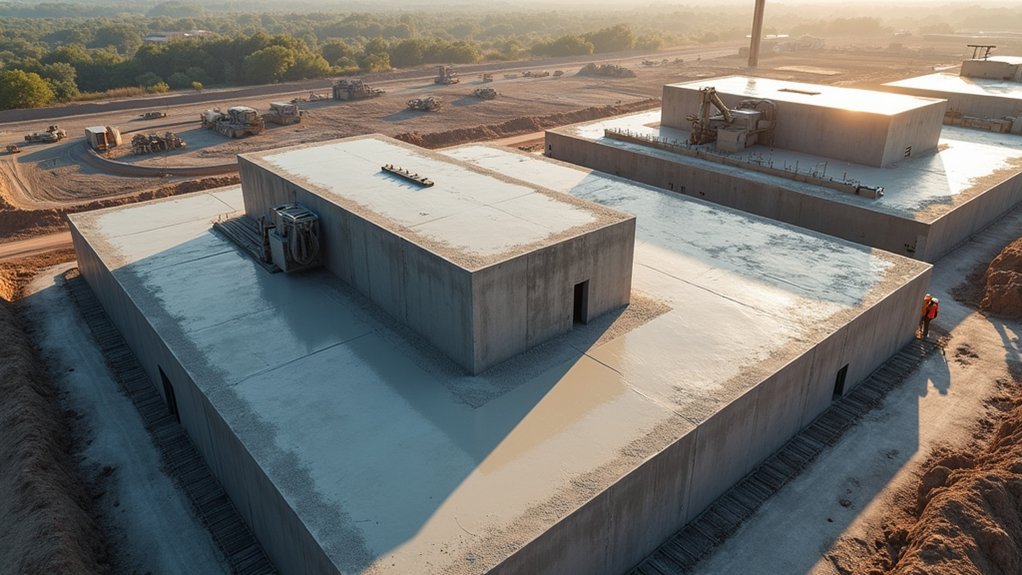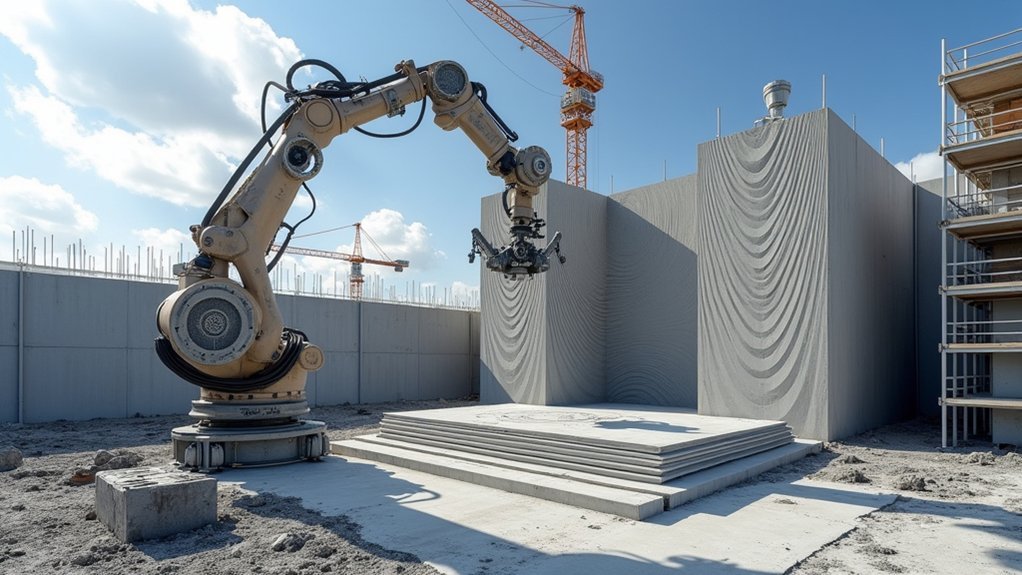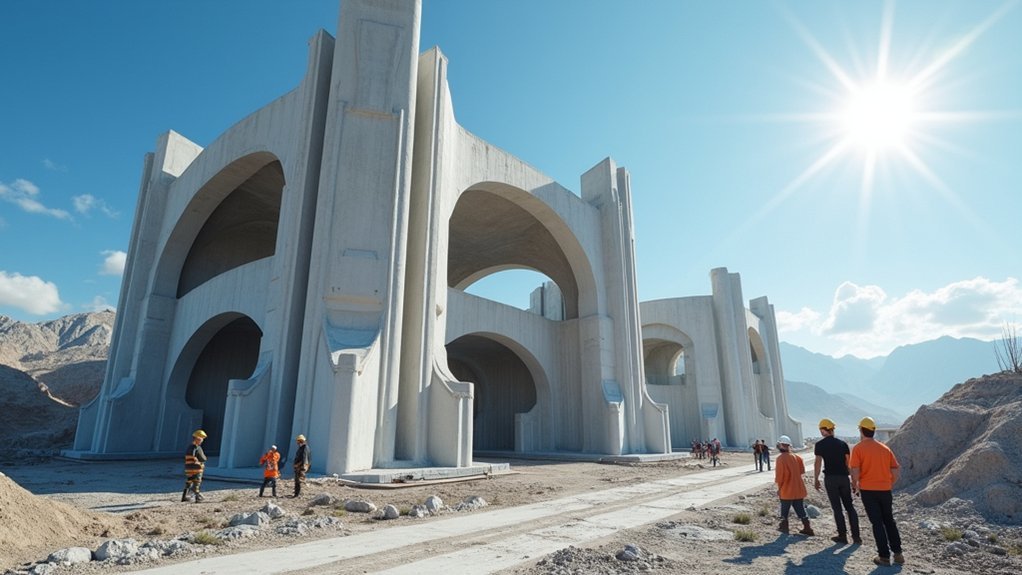You’re witnessing construction’s biggest revolution as large-scale 3D concrete printing transforms building sites worldwide. Robotic systems deposit engineered concrete layer by layer, reducing project timelines from months to days while cutting costs by up to 60%. This technology minimizes material waste, reduces workforce needs by 80%, and enables sustainable construction using recycled materials. With the market projected to grow from $190 million to $680 million by 2030, you’ll discover how this innovation addresses housing shortages while reshaping industry economics.
Technology Overview and Printing Process Fundamentals

Large-scale concrete printing revolutionizes construction by depositing specially formulated concrete layer by layer through robotic systems, creating complex structures directly from digital models.
This additive manufacturing technology transforms how you’ll approach construction projects. The printing process begins when you design structures using CAD software, which slices your 3D models into precise horizontal layers.
Digital design meets physical reality as CAD software transforms your architectural visions into precise, printable layers for robotic construction systems.
Robotic arms or specialized nozzle systems then deposit engineered concrete mixes that maintain fluidity while ensuring proper interlayer adhesion. You can achieve complex geometrical shapes impossible with traditional methods.
Building Information Modeling integration enhances your project efficiency by ensuring accurate material overlay during printing. This technology enables rapid construction timelines, with some projects completing in days, dramatically reducing your construction timeline compared to conventional building methods.
Material Requirements and Mix Design Considerations
You’ll need to carefully balance your mix design to achieve ideal extrudability and pumpability standards that prevent blockages during the printing process.
Your concrete must maintain sufficient workability time to allow for continuous layer placement while ensuring strong interlayer adhesion as each subsequent layer bonds with the previous one.
Managing these competing requirements means you’ll have to optimize viscosity, setting time, and flow characteristics to meet the demanding performance criteria of large-scale printing operations.
Extrudability and Pumpability Standards
When developing concrete mixes for large-scale printing applications, you must prioritize extrudability and pumpability as your primary material performance criteria.
You’ll need to maintain aggregate size below 10mm to prevent blockages in pumps and nozzles during concrete printing operations. Your mix design should balance viscosity for smooth flow while ensuring proper layering without structural collapse.
You can’t overlook workability requirements that directly impact your printing schedule. The open time determines how quickly you must complete each section before material becomes unworkable.
For ideal interlayer adhesion, you’ll need precise control over curing times between layers. This timing affects structural performance considerably, as poor bonding compromises the entire printed structure’s integrity and load-bearing capacity.
Layer Adhesion Requirements
Beyond achieving smooth material flow, your mix design must address the bond strength between consecutive layers to prevent structural failure. Layer adhesion in 3D concrete printing depends on maintaining ideal viscosity while managing your material’s open time to match printing speed. Your fresh concrete must remain workable long enough for proper interlayer adhesion without compromising structural integrity.
| Mix Component | Layer Adhesion Impact |
|---|---|
| Superplasticizers | Extends workability window |
| Fiber reinforcement | Bridges layer interfaces |
| Accelerators | Controls setting time |
| Viscosity modifiers | Maintains shape retention |
You’ll need to balance these factors carefully. Your concrete mix design should incorporate additives that enhance mechanical properties while supporting durability. The key lies in synchronizing material behavior with your printing process to achieve consistent bonding between layers throughout the entire structure.
Workability Time Management
While layer adhesion sets the foundation for structural integrity, managing workability time becomes the critical factor that determines whether your printing operation succeeds or fails.
You’ll need to maintain ideal workability time between 30-90 minutes for effective 3D concrete printing, ensuring your concrete mix remains placeable throughout the printing process. Your mix design must incorporate specific additives that extend open time while maintaining proper viscosity.
Fiber reinforcement enhances both workability and mechanical properties, improving layer adhesion and preventing cracks.
You must precisely control curing conditions and ambient temperature, as these dramatically influence setting times.
This workability time management revolutionizes traditional construction methods by enabling continuous printing operations without material waste or structural compromises.
Structural Performance and Load-Bearing Capabilities
You’ll need to implement strategic reinforcement approaches to maximize your 3D printed concrete’s structural capacity and guarantee it meets demanding construction requirements.
Your testing protocols must evaluate how these printed elements respond under various loading conditions, from compression to flexural stresses that mirror real-world applications.
You can’t overlook the critical relationship between interlayer adhesion and overall structural integrity when designing your reinforcement strategies.
Reinforcement Strategies Implementation
As you implement reinforcement strategies in large-scale 3D concrete printing, you’ll dramatically enhance your structure’s ability to handle demanding load-bearing applications.
You can incorporate steel fibers, synthetic fibers, and mesh to boost tensile strength and ductility, directly improving your structural performance. Different fiber concentrations will optimize both compressive and flexural strength for superior load-bearing capabilities.
You’ll need to focus on interlayer adhesion through specialized reinforcement techniques, effectively reducing delamination risks that compromise structural integrity.
By integrating advanced materials like high-performance concrete mixes, you’ll achieve exceptional mechanical properties under various loading conditions.
Field tests consistently demonstrate that well-executed reinforcement strategies enable your 3D-printed structures to match or surpass traditionally constructed elements, revolutionizing modern construction methods.
Loading Condition Testing
Before your 3D-printed concrete structures can bear real-world loads, thorough testing protocols must validate their structural integrity under diverse loading scenarios. Loading condition testing evaluates how your structures perform under bending, shear, and axial forces, ensuring they’ll meet safety requirements in real applications.
Your 3D-printed concrete’s structural performance depends heavily on interlayer adhesion, which you can optimize through precise printing conditions and material properties. Research shows you can achieve compressive strength and flexural strength comparable to traditional concrete when you implement proper reinforcement strategies.
| Test Type | Load Application | Performance Metric |
|---|---|---|
| Compressive | Axial compression | Ultimate strength |
| Flexural | Four-point bending | Modulus of rupture |
| Shear | Lateral forces | Shear resistance |
| Dynamic | Cyclic loading | Fatigue resistance |
| Bond | Interface testing | Adhesion strength |
These load-bearing capabilities inform your design principles for future projects.
Economic Benefits and Cost Analysis

While traditional construction methods often strain project budgets with high labor costs and material waste, large-scale concrete printing transforms the economic landscape by delivering unprecedented cost savings.
You’ll reduce construction costs by up to 60% through minimized material waste and streamlined processes. Labor expenses drop dramatically—automation cuts workforce needs by 80%, boosting economic efficiency across your projects.
The 3D printing market’s explosive growth from $190 million to $680 million by 2030 signals massive opportunities ahead.
You’ll achieve sustainable construction goals by incorporating recycled materials while reducing carbon emissions.
Though initial equipment investments run high, faster build times and reduced waste generate substantial financial returns, making this technology a smart long-term investment for your construction business.
Environmental Impact and Sustainability Advantages
When you implement large-scale concrete printing, you’re not just revolutionizing construction economics—you’re driving a sustainability revolution that greatly reduces your project’s environmental footprint.
You’ll achieve up to 60% material waste reduction compared to traditional methods while utilizing recycled materials and eco-friendly binders that minimize environmental impact. Your energy consumption drops considerably as faster construction speeds require less energy-intensive practices.
You can design structures incorporating energy-efficient features using local materials, promoting sustainable building practices.
This technology delivers reduced carbon emissions throughout production while addressing housing shortages responsibly. You’re creating affordable housing solutions that minimize ecological impact, aligning with global sustainability goals.
Large-scale concrete printing creates eco-friendly affordable housing while reducing carbon emissions and meeting global sustainability objectives responsibly.
Large-scale concrete printing transforms construction into an environmentally conscious industry that meets housing demands without compromising environmental responsibility.
Current Challenges and Technical Limitations

Despite large-scale concrete printing’s promising sustainability benefits, you’ll encounter significant technical and regulatory hurdles that currently limit its widespread adoption in construction projects.
The absence of standardized building codes for 3D concrete printing creates structural safety concerns and regulatory compliance issues that prevent widespread implementation in load-bearing applications.
You’ll face substantial initial investment costs for specialized machinery, deterring many firms from adopting this technology.
Material consistency poses another critical challenge, as concrete mix variations directly impact printed component quality and performance.
The construction industry’s conservative nature, combined with skilled workforce shortages and limited understanding of design principles, slows adaptation of new technologies.
Successfully implementing large-scale concrete printing requires significant technical expertise to operate advanced systems and transform traditional building practices.
Future Applications and Industry Adoption Trends
As the construction industry moves beyond current technical limitations, you’ll witness unprecedented market expansion in 3D concrete printing applications.
The market’s projected growth from $190 million to $680 million by 2030 demonstrates accelerating industry adoption trends. You’ll see printing technology revolutionizing construction methods through large-scale projects like ICON’s 100-home communities, addressing global housing shortages with rapid, affordable solutions.
Material science advances will enable sustainable development through recycled materials and eco-friendly binders, reducing environmental impact.
You’ll observe artificial intelligence and robotics integration improving precision and operational efficiency in innovative technologies. Government initiatives, particularly Dubai’s 3D printing promotion, are driving wider acceptance.
These developments position 3D concrete printing as a transformative force in modern construction industry practices.
Frequently Asked Questions
What Are the Advantages of Using Concrete in Large Scale Construction Projects?
You’ll benefit from concrete’s durability, cost-effectiveness, and versatility in large-scale projects. It’s fire-resistant, handles heavy loads well, requires minimal maintenance, and you can mold it into complex shapes while keeping construction expenses relatively low.
What Are the Benefits of 3D Concrete Printing in Construction?
You’ll reduce construction time dramatically, cut material waste by 60%, and lower labor costs by 80%. You can create complex designs easily while using recycled materials for sustainable building practices.
How Is 3D Printing Transforming Design Possibilities and Construction Speed?
You can now create intricate, customized architectural designs that weren’t possible before, while dramatically cutting construction timelines from months to mere days or hours through automated layer-by-layer printing processes.
How Much Does It Cost to Build a 3d-Printed Concrete House?
You’ll typically spend $10,000 to $200,000 building a 3D-printed concrete house, depending on size and complexity. You’ll save 30-50% compared to traditional construction, though you’ll need significant upfront investment for equipment.





Leave a Reply